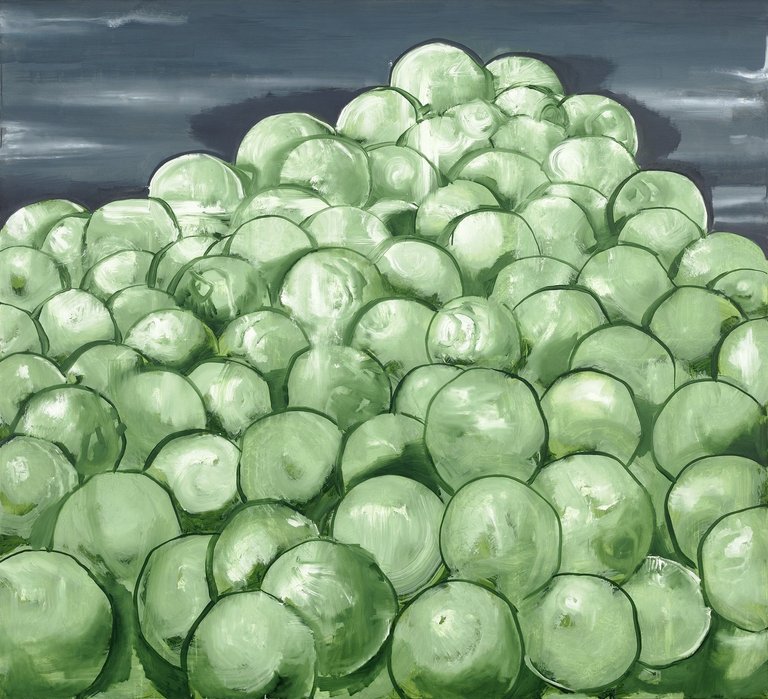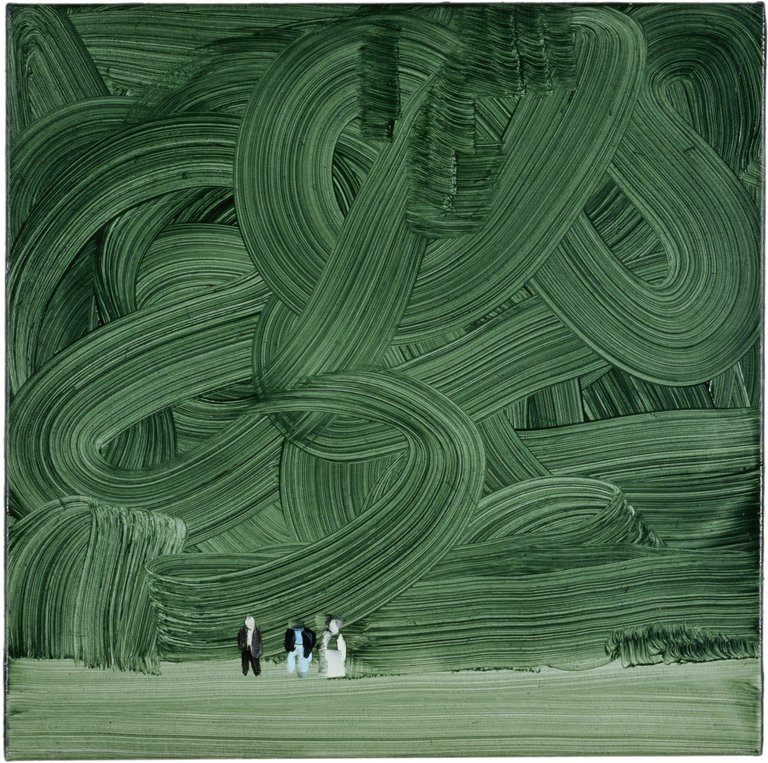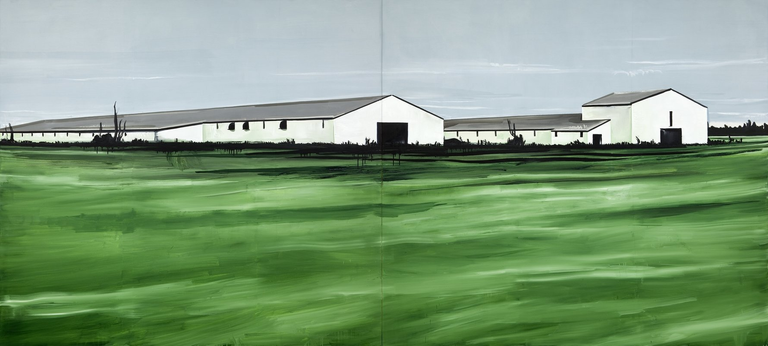Znacie prace Wilhelma Sasnala? To jeden z najbardziej znanych polskich współczesnych malarzy. Najdroższy z jego obrazów został wylicytowany za 465 tys. dolarów w 2008 roku (chyba że od tamtej pory była wyższa sprzedaż). Ostatnio mam trochę do czynienia z obrazami i miałem też okazję przyjrzeć się z bliska jednemu dziełu Sasnala. Wyobraźcie sobie, że one z bliska są jeszcze gorsze niż na zdjęciach z netu. Gość sobie walnął kreskę ołówkiem i nawet nie był w stanie zamalować równo wyznaczonego obszaru. Kreska tu i ówdzie wystaje 🤦. On by nie dał rady nawet ścian w pokoju pomalować. Za darmo byście go nie wzięli do tego celu. I jest typowy "artysta" dla współczesnej sztuki, czy raczej tego raka, który zdominował współczesną sztukę (bo wciąż istnieją normalni artyści, ale są mniej promowani i mniej widoczni).
Do you know the works of Wilhelm Sasnal? He is one of the most famous Polish contemporary painters. The most expensive of his paintings was auctioned for 465,000 USD in 2008 (unless there have been higher sales since then). Recently I have been dealing with paintings a bit at work and I also had the opportunity to take a closer look at one of Sasnal's works. Imagine that they are even worse up close than in the photos online. This guy put up the line with his pencil and wasn't even able to paint over the designated area evenly. The line sticks out here and there 🤦. He wouldn't even be able to paint the walls in his room. You wouldn't hire him for free for this purpose. And he is a typical "artist" for "contemporary art", or rather this cancer that dominates contemporary art (there are still some normal artists, but they are less promoted and less visible).
Ktoś mógłby powiedzieć, że nie chodzi o technikę, ale o przekaz. Taa, głęboki filozoficzny przekaz < irony mode off >. Sasnal jest i tak nie najgorszy, bo jest po prostu nudny, banalny i nie ma nic do powiedzenia w swoich maziajach. Bo najbardziej cenieni są ci, którzy poprzez tę prymitywną formę dają upust swoim fiksacjom seksualnym i innym. I warunek podstawowy, bez spełnienia którego jakakolwiek kariera w sztuce jest niemożliwa - lewicowe poglądy polityczne. Znaczy neomarksistowskie (tęczowe), bo na klasyczną lewicę z czasów PZPR to raczej też miejsca nie ma.
Someone might say that it's not about the technique, but about the message. Yeah, a deep philosophical message < irony mode off >. Sasnal isn't the worst anyway, because he's just boring, banal and has nothing to say in his low quality paintings. The most appreciated are those who give vent to their sexual and other fixations through this primitive form. And the basic condition without which any career in art is impossible - leftist political views. I mean neo-Marxist (rainbow), because there is probably also no room for the classic left from the times of the Polish United Workers' Party.
Tak - są gorsze obrazy od tych autorstwa Sasnala i nie będę ich pokazywał, ale możecie sobie sami sprawdzić np. Jean-Michel Basquiat, Cady Noland, Carroll Dunham, Sverre Bjertnæs, Hermann Nitsch i pierdyliard innych. Zastanawiam się, czy za konieczność patrzenia na złą sztukę nie powinien przysługiwać jakiś dodatek za pracę w szkodliwych warunkach...
Yes - there are worse paintings than those by Sasnal and I won't show them, but you can check them out for yourself, e.g. Jean-Michel Basquiat, Cady Noland, Carroll Dunham, Sverre Bjertnæs, Hermann Nitsch and a billion of others. I wonder whether there should be some allowance for working in harmful conditions for having to look at bad art...
Ale do rzeczy. Nie bez powodu sfera sztuki jest obecnie zdominowana przez totalny syf. Nie stało się to z dnia na dzień, ten proces trwał wiele lat, nawet trudno znaleźć wyraźny moment początkowy (choć mówi się o wystawieniu pisuaru w muzeum przez Duchampa w 1917 roku). To był jednak pewien proces, wynikający z jednej strony z miałkości współczesnych "intelektualistów" doby "demokracji socjalnej" oraz dominacji państwowych instytucji, z drugiej celowej próby podporządkowania sfery sztuki nowej formie rewolucji przez neomarksistów w rodzaju przedstawicieli Szkoły Frankfurckiej i innych rozczarowanych tym, że niewdzięczny, zachodni robotnik dorobił się w kapitalizmie i pogardził rewolucją komunistyczną. Czyli "długi marsz przez instytucje", w tym również instytucje zajmujące się sztuką.
But to the point. It is not without reason that the sphere of art is currently dominated by total crap. It did not happen overnight, this process took many years, it is even difficult to find a clear starting moment (although some say that Duchamp exhibiting a urinal in a museum in 1917 made the starting point of this). However, it was a certain process, resulting on the one hand from the shallowness of modern "intellectuals" in the era of "social democracy" and the domination of state institutions, and on the other hand from a deliberate attempt to subordinate the sphere of art to a new form of revolution by neo-Marxists such as representatives of the Frankfurt School and others disappointed with the fact that the ungrateful worker from the West made his fortune in capitalism and despised the communist revolution. That is, "a long march through institutions", including institutions dealing with art.
Dlatego polecam ciekawą rozmowę na ten temat, którą przeprowadził Jakub Zgierski (czyli dość znany w kręgach prawicy ideowej popularyzator myśli Krzysztofa Karonia) z Romanem Konikiem (profesor Uniwersytetu Wrocławskiego, kieruje Zakładem Estetyki w Instytucie Filozofii, znany też z autorstwa książki "W obronie Świętej Inkwizycji"):
Therefore, I recommend an interesting conversation on this topic, conducted by Jakub Zgierski with Roman Konik (professor of the University of Wrocław, head of the Department of Aesthetics at the Institute of Philosophy).
Unfortunately, there are no English subtitles available for this conversation. However, if you know any interesting materials in English analyzing or discussing the causes of the degeneration of art, please share it in the comment.
https://rumble.com/v4rp7u6-roman-konik-sztuka-wspczesna-czy-bekot.html



Dodam na koniec rzecz o której pan profesor wspomina w rozmowie. Pod tym adresem można znaleźć blog, na którym Roman Konik prezentuje ciekawych artystów współczesnych, którzy mają cos ciekawego do powiedzenia i pokazania (w odróżnieniu od tych, którzy dominują w tej dziedzinie):
Finally, I will add something that the professor mentions in the conversation. At this address you can find a blog where Roman Konik presents interesting contemporary artists who have something interesting to say and show (unlike those who dominate in this field):





